Streamlining Secret Management with Vault in K3s Kubernetes
Table of Contents
This post will explore deploying Hashicorp Vault to K3s (Kubernetes distribution) using Helm and then configuring it with Terraform. This will enable us to store our secret state data in Vault and make those secrets available to our K3s resources.
Vault is an enterprise level secrets manager configurable for high availability which integrates with Kubernetes and many CI toolsets.
In the previous two posts journaling the evolution of this site’s delivery, we have been managing a single secret, the Cloudflared tunnel token.
This secret has extended our process in both posts in taking precautionary steps not to include it in source control.
The prior approach was having an .example secret state file, adding the actual file to .gitignore, and documenting instructions on creating the real file manually. This becomes increasingly cumbersome and error-prone with the more secrets we add.
Using Vault for one secret is like dropping a shipping container of hammers onto a small nail to hit the nail in. This post is about learning to use the tools, for the example use case there are more elegant solutions.
Note, we are building upon the previous post which got our GitHub repo to here.
Example#
Checkout the end result in GitHub
References#
Vault docs for installing on Minikube - followed this closely up until using Terraform.
It goes into more detail about what the steps prior to Terraform are doing.
Tech Stack#
- K3s
- Ubuntu Linux
- Helm
- Hashicorp Vault
- Consul
- Terraform
Bring Your Own#
- Host running Ubuntu Linux
- e.g. VirtualBox VM, Bare metal host, Virtual Private Server (VPS), WSL2
- K3s installed on host
Steps#
Install Helm#
Install Helm and jq#
sudo snap install helm --classic
sudo apt install jq
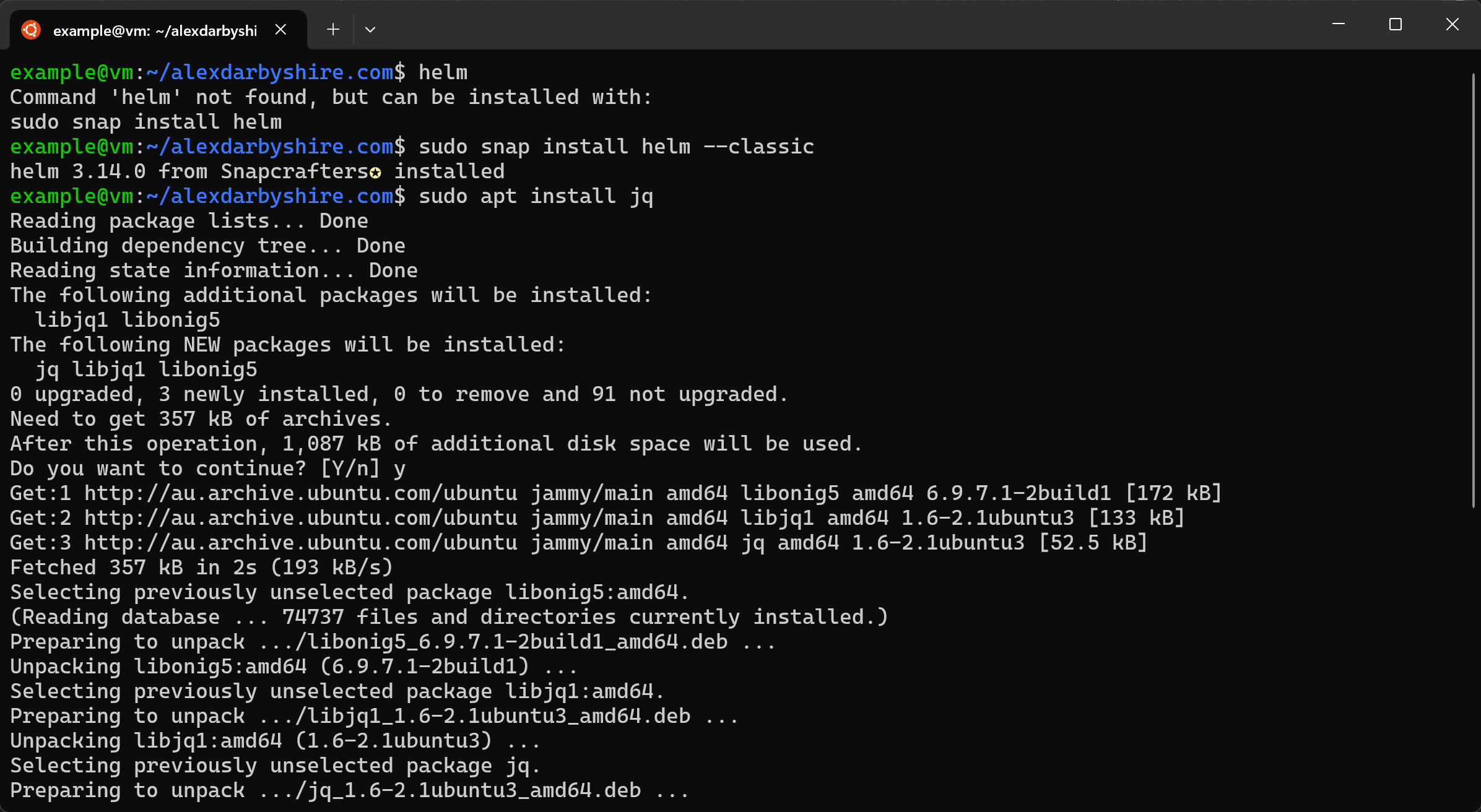
jq is a small command line tool for parsing JSON in shells, we use it later with some JSON output from Vault.
Set KUBECONFIG Environment Variable#
We need to let Helm know where to find the kube config file.
We could do this for the session only, or a specific user, or all users. Here we have gone for setting it system-wide.
echo "KUBECONFIG=/etc/rancher/k3s/k3s.yaml" | sudo tee -a /etc/environment
echo /etc/environment
The shell will need to be renewed for the added environment variable to take effect. When using SSH, exit and reconnect will work.
Note we used piped the stdout of the echo command to sudo tee instead of the shorthand >> append operator as the shorthand will not work when the executing user doesn’t have write permissions for the file.
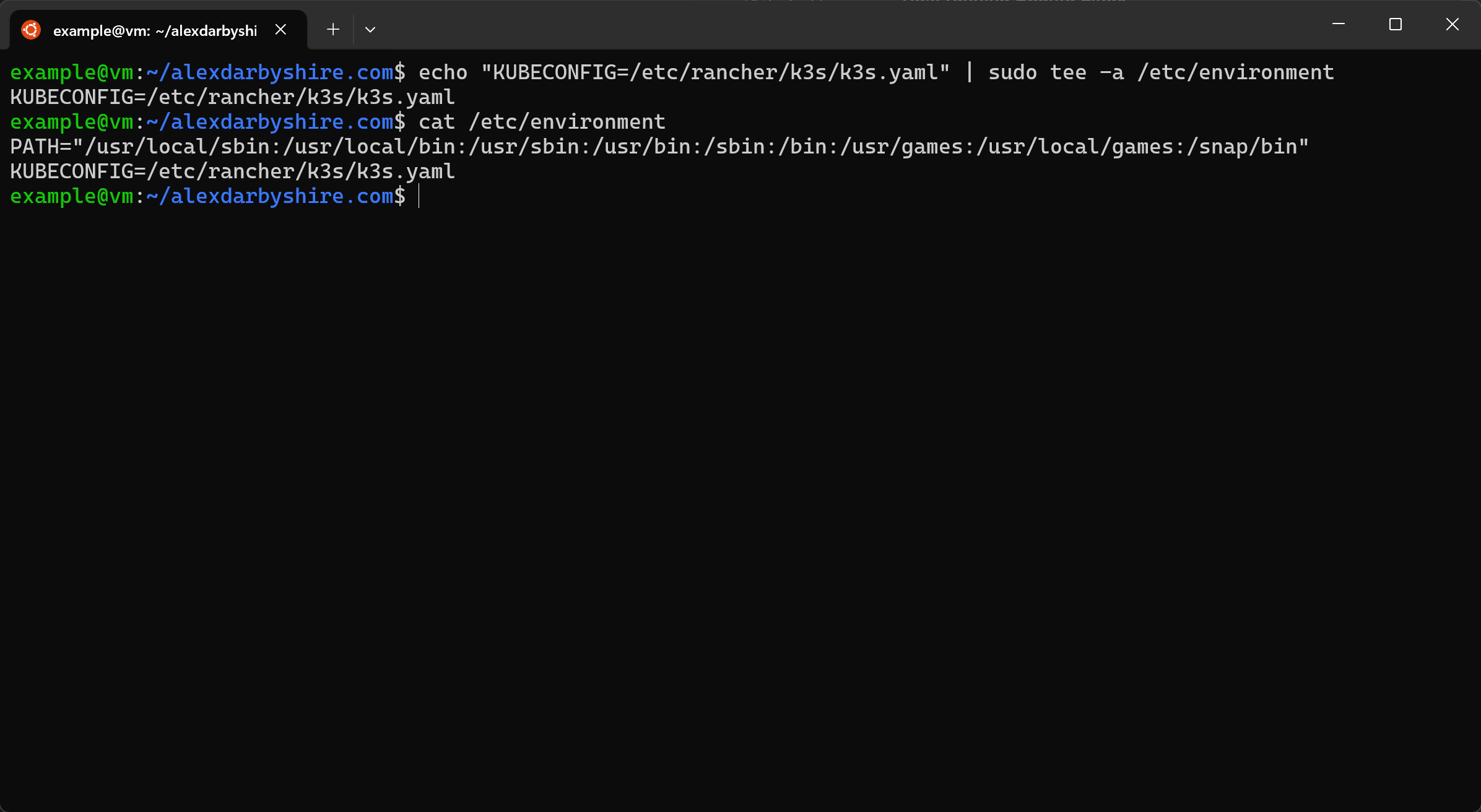
Alternative option for KUBECONFIG#
This method exports a copy of the kube config to the user’s home directory and adds the KUBECONFIG environment variable for the user.
This way sudo is no longer needed to run kubectl as it no longer needs access to /etc/rancher/k3s/k3s.yaml.
mkdir ~/kube
sudo k3s kubectl config view --raw > ~/.kube/config
chmod 600 ~/.kube/config
echo "export KUBECONFIG=~/.kube/config" >> ~/.profile
Setup Vault and Consul#
Add and Update Hashicorp Helm Repository#
sudo helm repo add hashicorp https://helm.releases.hashicorp.com
sudo helm repo update
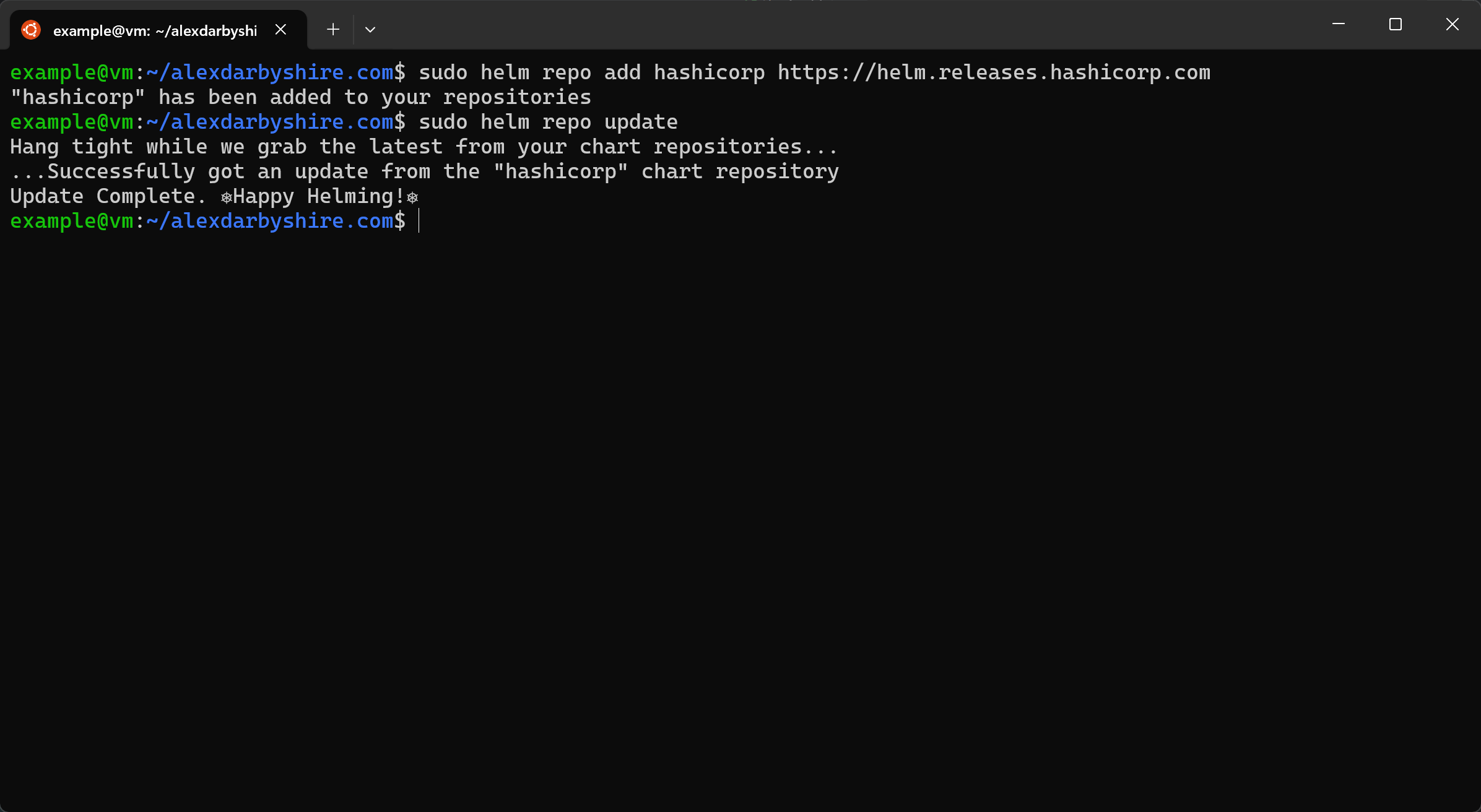
Add Helm Value File for Consul#
Create a file deploy/helm-consul-values.yaml with contents:
global:
datacenter: vault-kubernetes
client:
enabled: true
server:
replicas: 1
bootstrapExpect: 1
disruptionBudget:
maxUnavailable: 0
The Helm chart for Consul accepts these parameters.
Add Helm Value File for Vault#
Create a file deploy/helm-vault-values.yaml with contents:
server:
affinity: ""
ha:
enabled: true
Install Consul and Vault#
sudo helm install consul hashicorp/consul --values deploy/helm-consul-values.yaml
sudo helm install vault hashicorp/vault --values deploy/helm-vault-values.yaml
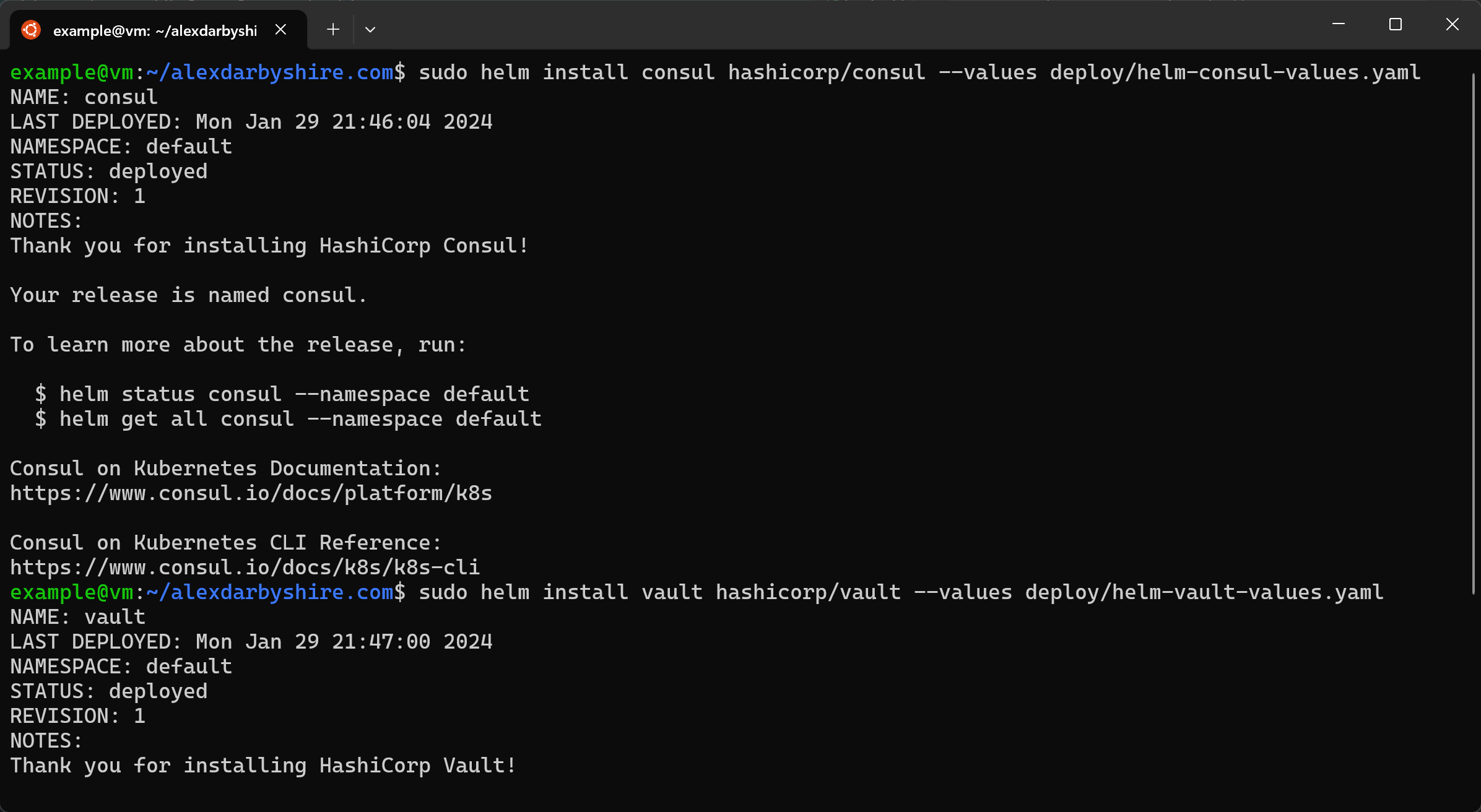
Check the Pods#
sudo k3s kubectl get pods
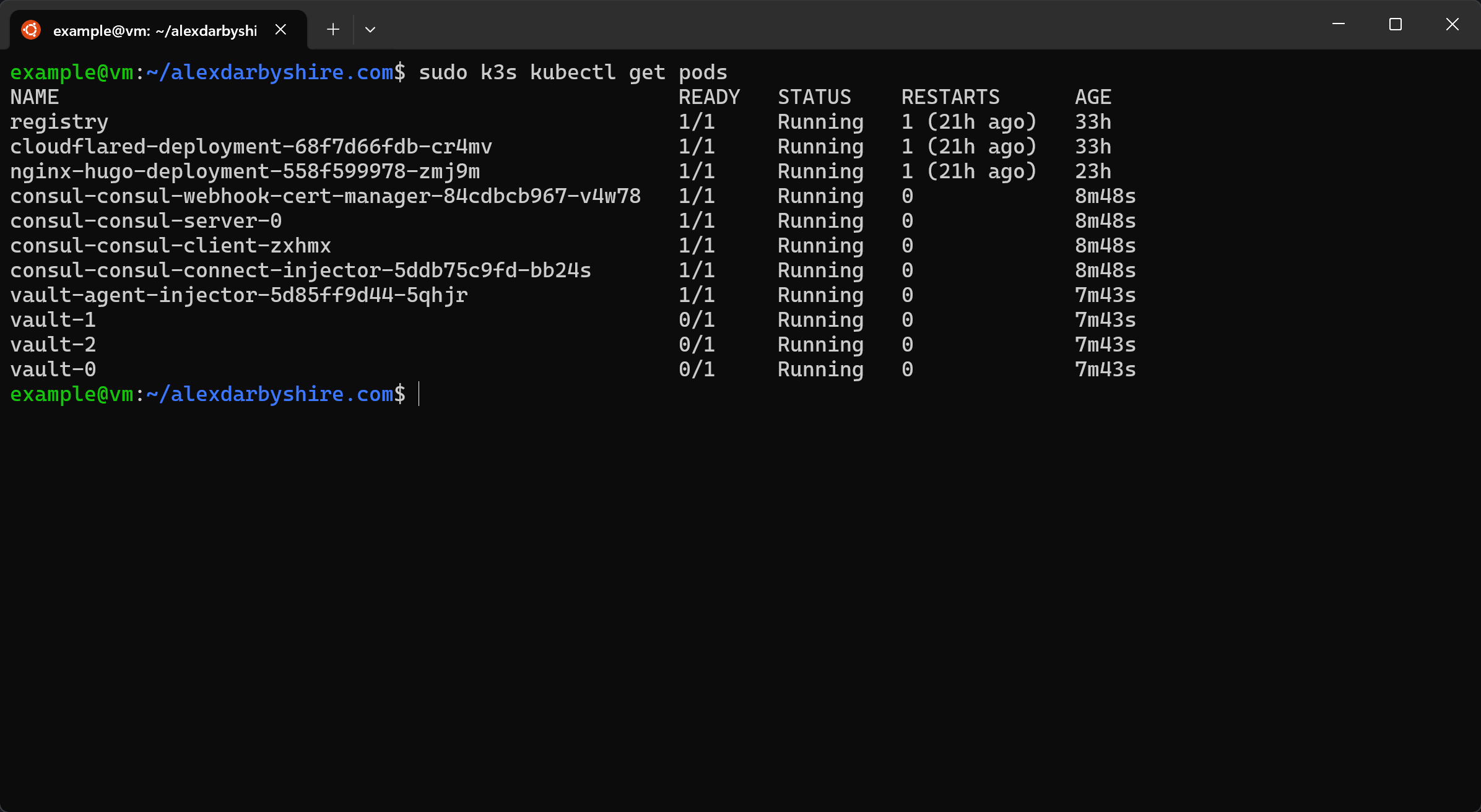
We can see our Vault pods aren’t ready.
Execute a command in one of the Vault pods to get Vault’s status
sudo k3s kubectl exec vault-0 -- vault status
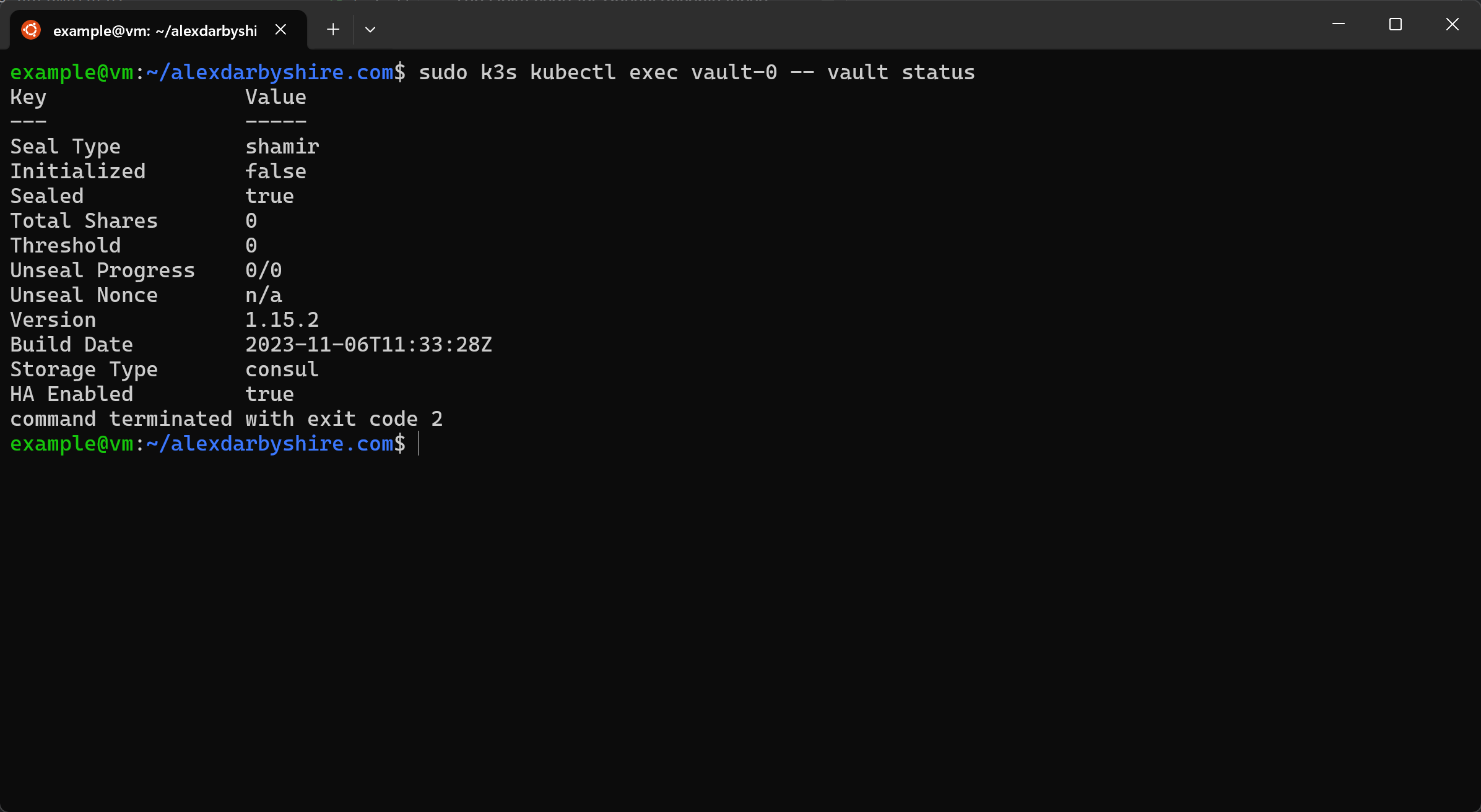 We need to initialise and unseal the Vault.
We need to initialise and unseal the Vault.
Configure Vault#
Initialise Vault and Generate Unseal Keys#
We’ll set the number of keys generated and the number of keys required to unseal to 2 and output those keys to a JSON file.
sudo k3s kubectl exec vault-0 -- vault operator init -key-shares=2 -key-threshold=2 -format=json > cluster-keys.json
Here is what the outputted file looks like:

Unseal the Vault#
We want to read the keys out of the JSON and pass them to Vault. We could do something like
sudo k3s kubectl exec vault-0 -- vault operator unseal $(jq -r '.unseal_keys_b64[0]' cluster-keys.json)
This would keep the keys out of our bash history, it could expose keys to other users on the host who are monitoring processes.
Instead we’ll use xargs to positionally apply the piped out of jq. Note to self, come back and refactor this.
jq -r '.unseal_keys_b64[0]' cluster-keys.json | xargs -I {} sudo k3s kubectl exec vault-0 -- vault operator unseal "{}"
jq -r '.unseal_keys_b64[1]' cluster-keys.json | xargs -I {} sudo k3s kubectl exec vault-0 -- vault operator unseal "{}"
jq -r '.unseal_keys_b64[0]' cluster-keys.json | xargs -I {} sudo k3s kubectl exec vault-1 -- vault operator unseal "{}"
jq -r '.unseal_keys_b64[1]' cluster-keys.json | xargs -I {} sudo k3s kubectl exec vault-1 -- vault operator unseal "{}"
jq -r '.unseal_keys_b64[0]' cluster-keys.json | xargs -I {} sudo k3s kubectl exec vault-2 -- vault operator unseal "{}"
jq -r '.unseal_keys_b64[1]' cluster-keys.json | xargs -I {} sudo k3s kubectl exec vault-2 -- vault operator unseal "{}"

Make note of the root_token in the cluster-keys.json, we’ll use it shortly.
Note: Now that we have unlock the keys for the first time, take the contents of the cluster-keys.json and put it somewhere safe like a decent password manager with multifactor authentication enabled. If it was for something sensitive, use increased and appropriate precautions commensurate to risk.
Then after making a copy of the contents, I suggest getting rid of the file, rm cluster-keys.json
Checking the pods now should have them all showing as available.
Configure Terraform#
Originally intended to leave Terraform for a later post and using Vault .hcl files and the command line, then this post would have been very similar to Vault’s minikube tutorial.
On reflection, we may as well get started with Terraform now.
Install Terraform#
Add the package repositories key, and use the apt package manager to install Terraform.
wget -O- https://apt.releases.hashicorp.com/gpg | sudo gpg --dearmor -o /usr/share/keyrings/hashicorp-archive-keyring.gpg
echo "deb [signed-by=/usr/share/keyrings/hashicorp-archive-keyring.gpg] https://apt.releases.hashicorp.com $(lsb_release -cs) main" | sudo tee /etc/apt/sources.list.d/hashicorp.list
sudo apt update && sudo apt install terraform
Create the Terraform files for configuring Vault#
There are a few files to create, rather than list all contents here, click this link to the GitHub repo.
- main.tf - defines the Vault provider to inform Terraform of how to interact with the rest of the files
- secrets.tf - enables kv-v2 (Key Value) secret engine
- auth.tf - enables Kubernetes auth backend and add a service-account for cloudflared with the required policy to allow access to the secrets intended path
- policies.tf - Barrel file that specifies which Vault policies (in Vault’s standard
.hclformat) should be loaded - polices/cloudflared-policy.hcl - a policy to allow CRU (Create, Read, Update) access to cloudflared path in enabled secrets engine

Provision Vault#
Temporarily expose the Vault management port the host, run this in a second shell as it runs in the foreground (or run in background using screen or similar and remember to kill it).
sudo k3s kubectl port-forward vault-0 8200:8200
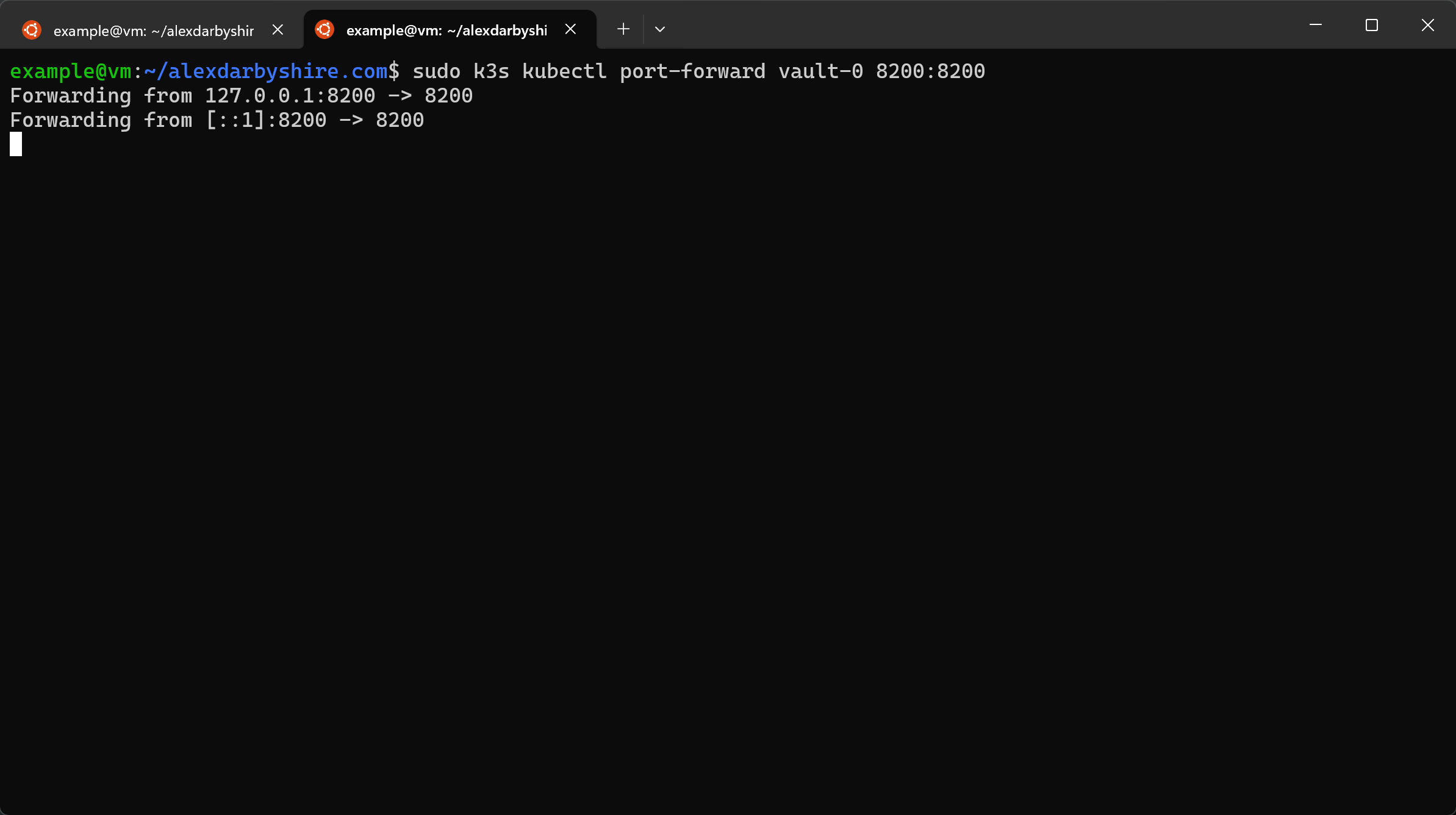
Set the resulting address as the standard VAULT_ADDR environment variable, set the token as an environment to give Terraform the address and the door pass.
Security This will expose the token in the shell history and in memory on the host.
Then initialise the Terraform with the Vault provider, and apply the config.
export VAULT_ADDR="http://127.0.0.1:8200"
export VAULT_TOKEN=insert_the_root_token_we_got_from_cluster-keys.json
terraform init
terraform apply
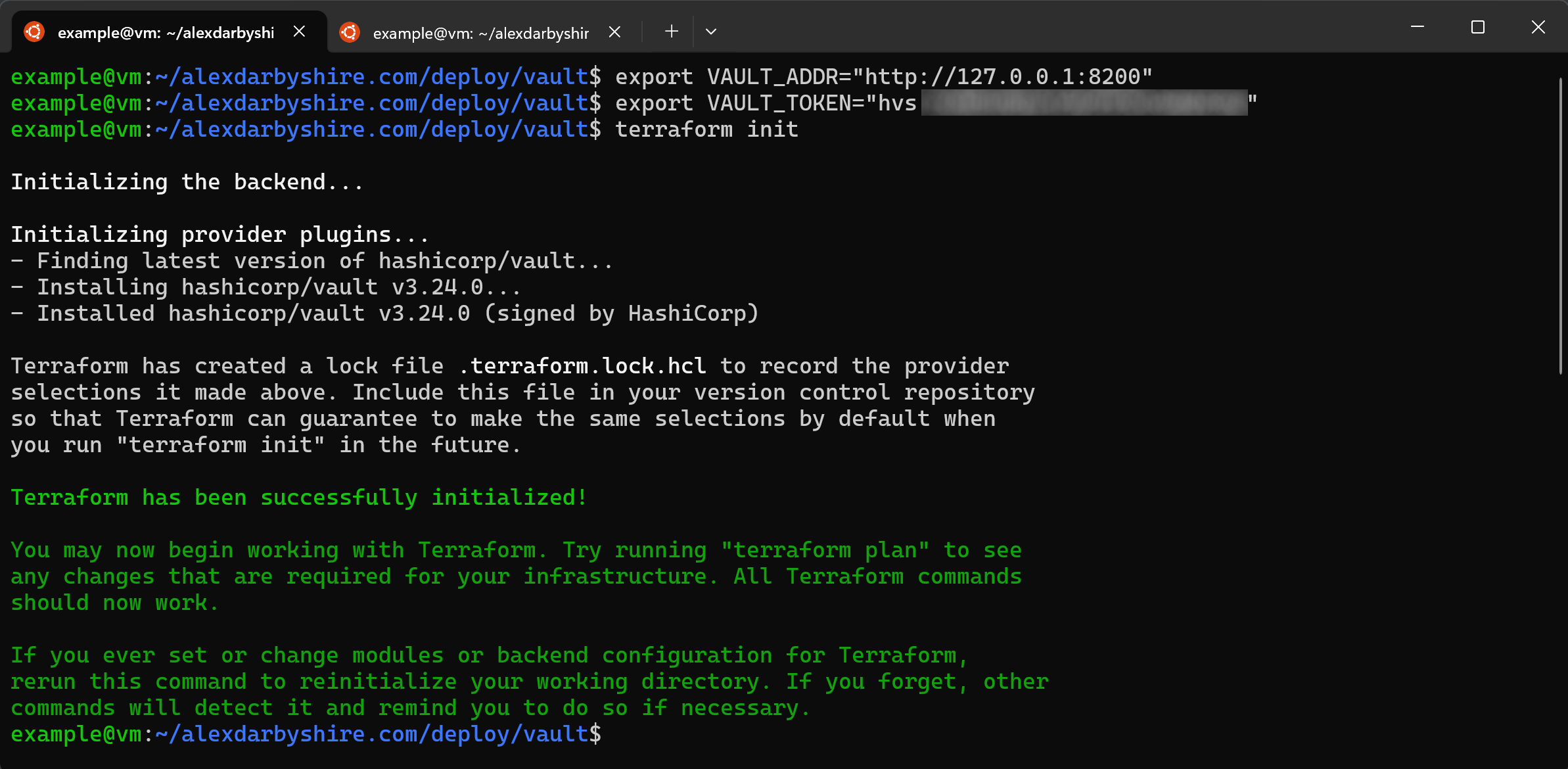
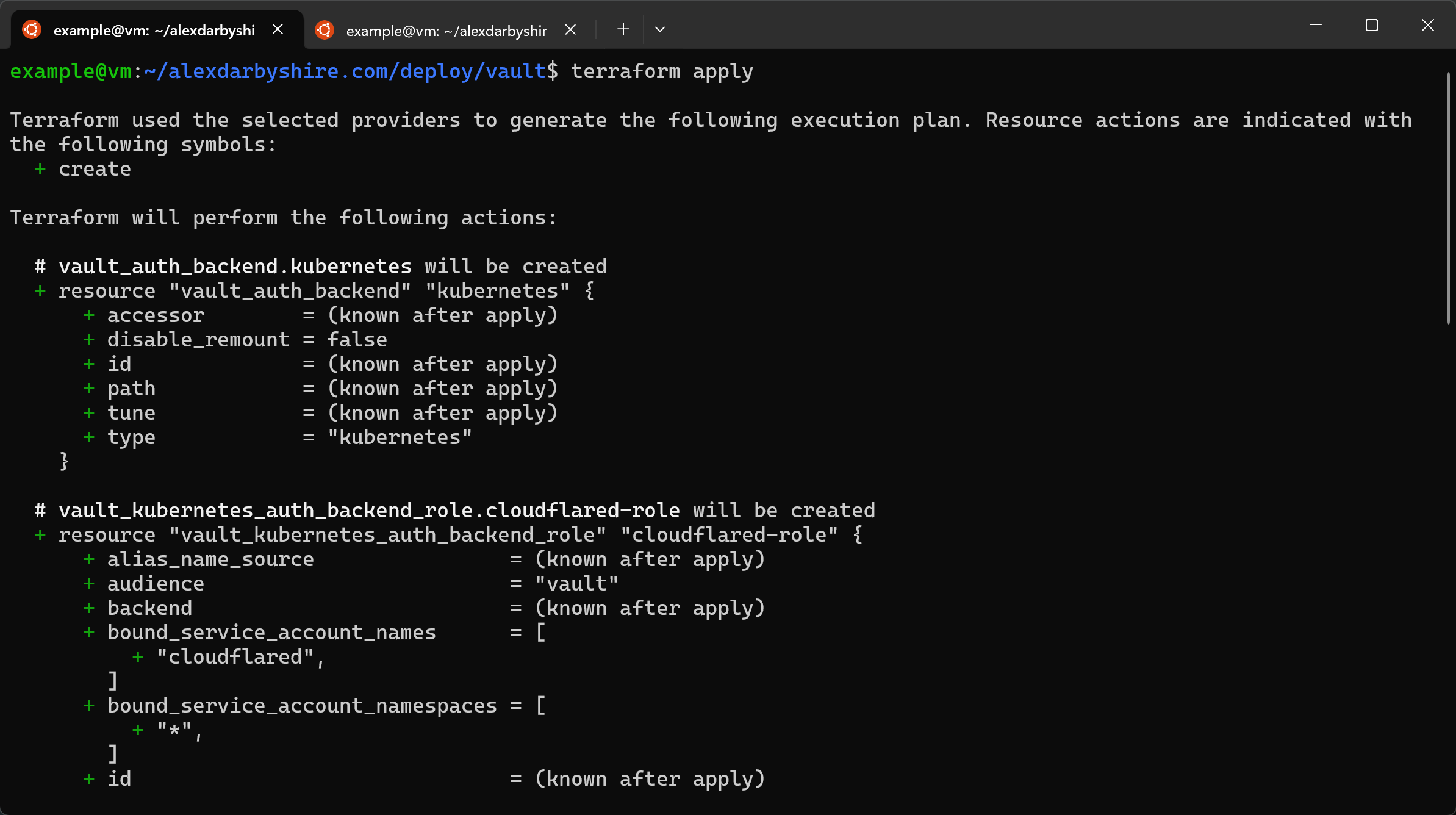
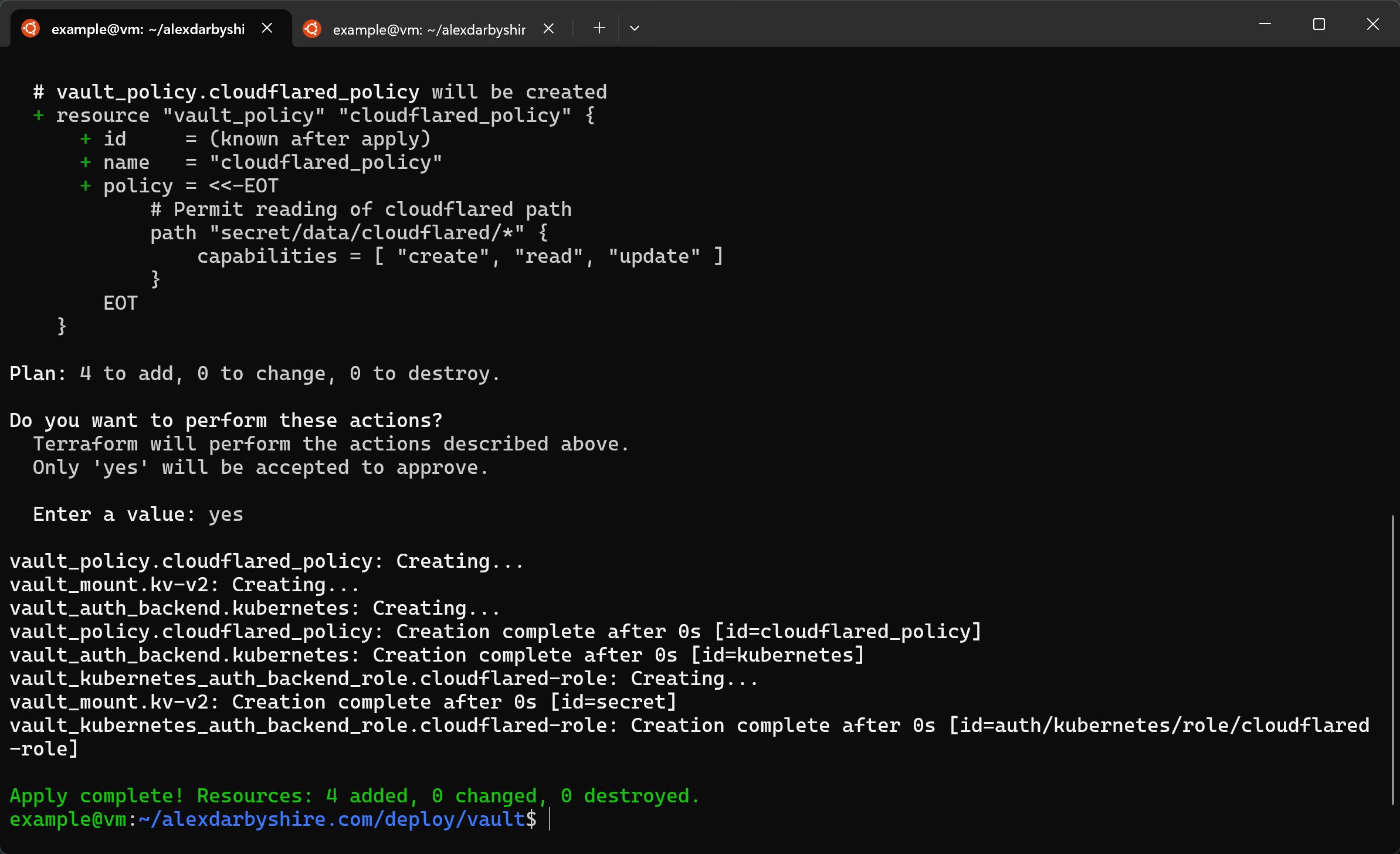
Add Cloudflared Token to Vault#
We still do this step manually as we don’t want to add credentials to the Terraform files.
Remember that we base64 encoded the token before adding it to our .env file, so if sourcing it from there decode it echo "token_here" | base64 -d or just get the original from the Cloudflare UI.
sudo k3s kubectl exec --stdin=true --tty=true vault-0 -- /bin/sh
vault login
vault kv put secret/cloudflared/tunnel token="insert_cloudflared_tunnel_token"
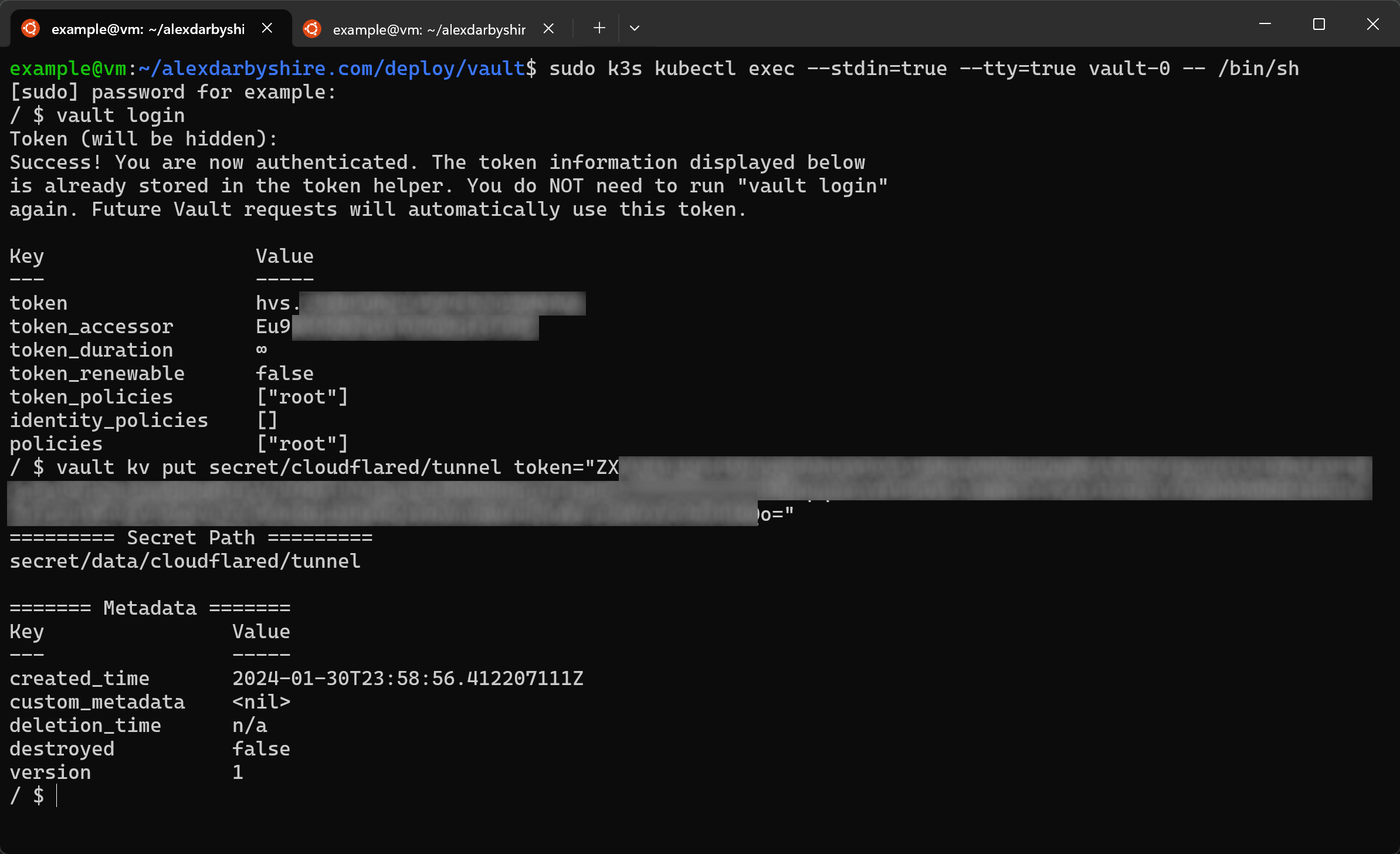
Confirm Terraform success#
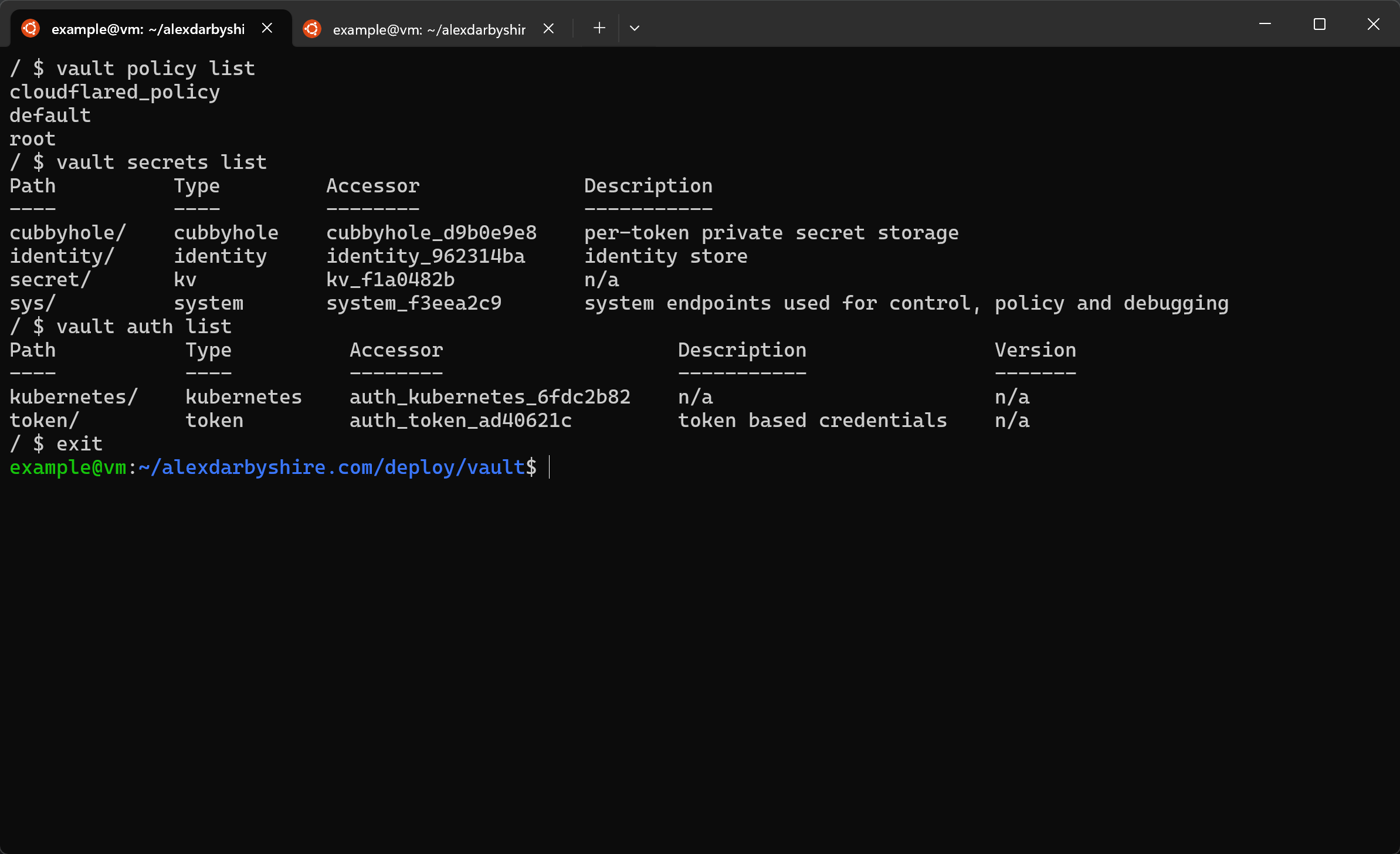
Add Secret to Vault and Retrieve#
In the section we bring it all together by implementing a Vault sidecar service to inject our secret as the TUNNEL_TOKEN environment variable.
There is a slight challenge to solve in doing this. The stock Cloudflared image does not have a shell and to inject environment variables from Vault into pods we need a shell. Also, the cloudflared application does not allow reading the token from a file.
Three solutions come to mind:
- Create our own image with the cloudflared application and a shell.
- Re-work our use of Cloudflared to use a tunnel credentials file, the cloudflared application has a param for reading these from the file system.
- Create an init container which reads the injected secret and then adds it to the K3s secrets engine (which can then be set as an environment variables without a shell)
Will use method 3 for now. In a future post we might look at using the Cloudflared API via Terraform or directly to get our tunnel creation included as part of config as code.
Move Helm config files#
These are mixed up with our Kubernetes files, moving them to their own directory will make life easier.
mkdir helm
mv helm-* helm/
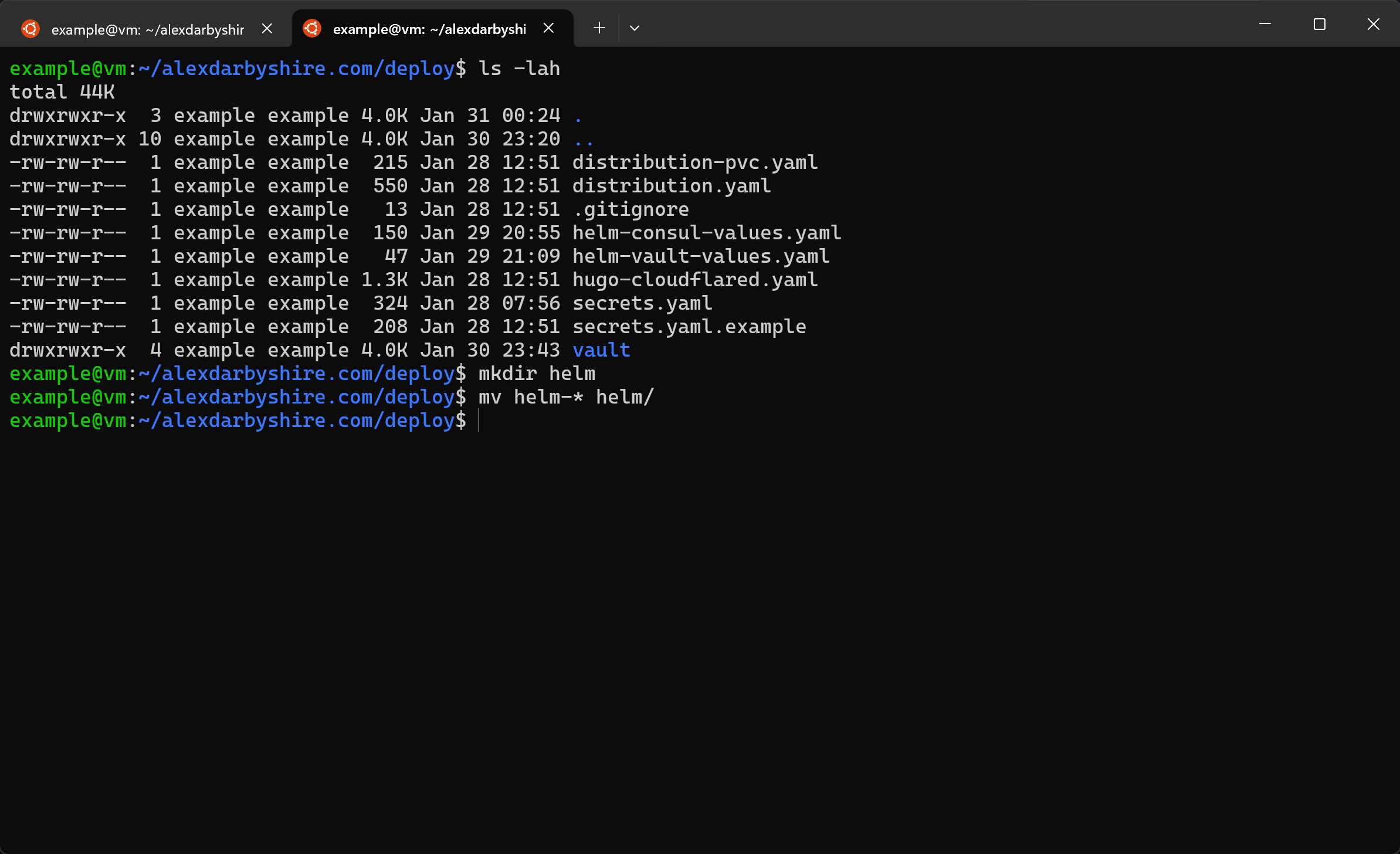
Add K3s service account and secret#
Add file deploy/vault-auth-service-account.yaml with the following content:
apiVersion: v1
kind: ServiceAccount
metadata:
name: vault-auth
namespace: default
---
apiVersion: rbac.authorization.k8s.io/v1
kind: ClusterRole
metadata:
name: secret-admin
rules:
- apiGroups: [""]
resources: ["secrets"]
verbs: ["create", "get", "watch", "list", "patch", "delete"]
---
apiVersion: rbac.authorization.k8s.io/v1
kind: ClusterRoleBinding
metadata:
name: role-tokenreview-binding
namespace: default
roleRef:
apiGroup: rbac.authorization.k8s.io
kind: ClusterRole
name: system:auth-delegator
subjects:
- kind: ServiceAccount
name: vault-auth
namespace: default
---
apiVersion: rbac.authorization.k8s.io/v1
kind: ClusterRoleBinding
metadata:
name: role-secretadmin-binding
namespace: default
roleRef:
apiGroup: rbac.authorization.k8s.io
kind: ClusterRole
name: secret-admin
subjects:
- kind: ServiceAccount
name: vault-auth
namespace: default
---
This:
- creates a service account called vault-auth,
- creates a role called secret-admin which can administer Vault secrets,
- binds two roles to service account
- an inbuilt role
system:auth-delegatorwhich will provide a short-lived Vault token inside any pods with the service account, and - the secret-admin role we created.
- an inbuilt role
Add file deploy/vault-auth-secret.yaml with the content:
apiVersion: v1
kind: Secret
metadata:
name: vault-auth-secret
annotations:
kubernetes.io/service-account.name: vault-auth
type: kubernetes.io/service-account-token
Apply the new manifests.
sudo k3s kubectl apply -f vault-auth-service-account.yaml,vault-auth-secret.yaml
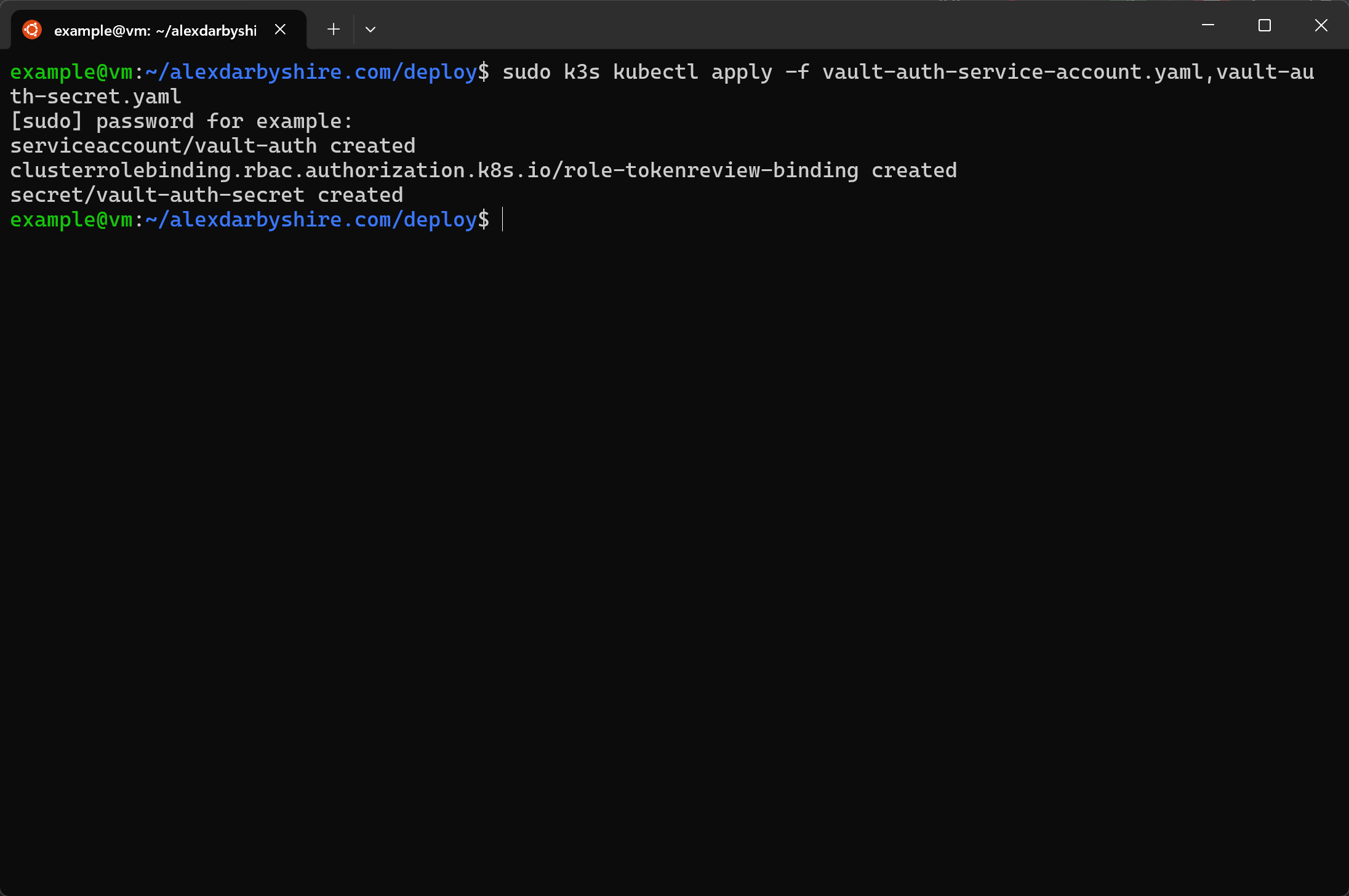
Update Cloudflared Manifest to use secret from Vault#
We’ll use a Vault Agent Sidecar and a few tricks to inject the Cloudflared tunnel token into our Cloudflared pods as an environment variable.
We will also improve our Cloudflared K3s deployment definition which is pretty basic after using Kompose to migrate, e.g. it doesn’t have a healthcheck.
The sidecar is configured using annotations in the Deployment manifest’s template key.
The injected secret is accessible through a pod’s filesystem. We use an initContainer to get the secret from the filesystem and add it in to K8s secret store to allow it to be loaded as an environment variable before the cloudflared container starts.
There is a bit of added complexity with Cloudflared not having a shell and not accepting the tunnel token from a file. Will definitely be looking at using a Cloudflare credential file type workflow in future.
In deploy/hugo-cloudflared.yaml, update the Cloudflared deployment section to:
apiVersion: apps/v1
kind: Deployment
metadata:
labels:
app: cloudflared
name: cloudflared-deployment
spec:
replicas: 2
selector:
matchLabels:
app: cloudflared
template:
metadata:
labels:
app: cloudflared
annotations:
vault.hashicorp.com/agent-inject: 'true'
vault.hashicorp.com/agent-init-first: 'true'
vault.hashicorp.com/role: 'cloudflared-role'
vault.hashicorp.com/agent-inject-secret-token: 'secret/cloudflared/tunnel'
vault.hashicorp.com/agent-inject-template-token: |
{{- with secret "secret/cloudflared/tunnel" -}}
export TUNNEL_TOKEN="{{ .Data.data.token }}"
{{- end }}
spec:
serviceAccountName: vault-auth
initContainers:
- image: docker.io/alpine/k8s:1.25.6
name: create-auth-token
command:
- /bin/sh
- -c
- |
source /vault/secrets/token
kubectl delete secret cloudflared --ignore-not-found > /dev/null 2>&1
kubectl create secret generic cloudflared --from-literal="token=$TUNNEL_TOKEN"
containers:
- image: cloudflare/cloudflared:latest
name: cloudflared
args:
- tunnel
- --no-autoupdate
- --metrics=0.0.0.0:3333
- run
- tunnel
env:
- name: TUNNEL_TOKEN
valueFrom:
secretKeyRef:
name: cloudflared
key: token
livenessProbe:
httpGet:
path: /ready
port: 3333
scheme: HTTP
readinessProbe:
httpGet:
path: /ready
port: 3333
scheme: HTTP
startupProbe:
httpGet:
path: /ready
port: 3333
scheme: HTTP
failureThreshold: 60
periodSeconds: 10
restartPolicy: Always
---
apiVersion: apps/v1
kind: Deployment
metadata:
labels:
app: nginx-hugo
name: nginx-hugo-deployment
spec:
replicas: 1
selector:
matchLabels:
app: nginx-hugo
template:
metadata:
labels:
app: nginx-hugo
spec:
containers:
- image: localhost:5000/alexdarbyshire-site:latest
name: nginx-hugo
ports:
- containerPort: 80
restartPolicy: Always
---
apiVersion: v1
kind: Service
metadata:
name: nginx-hugo
spec:
selector:
app: nginx-hugo
ports:
- protocol: TCP
port: 80
targetPort: 80
---
Patch the resource and check the pods#
sudo k3s kubectl patch -f hugo-cloudflared.yaml
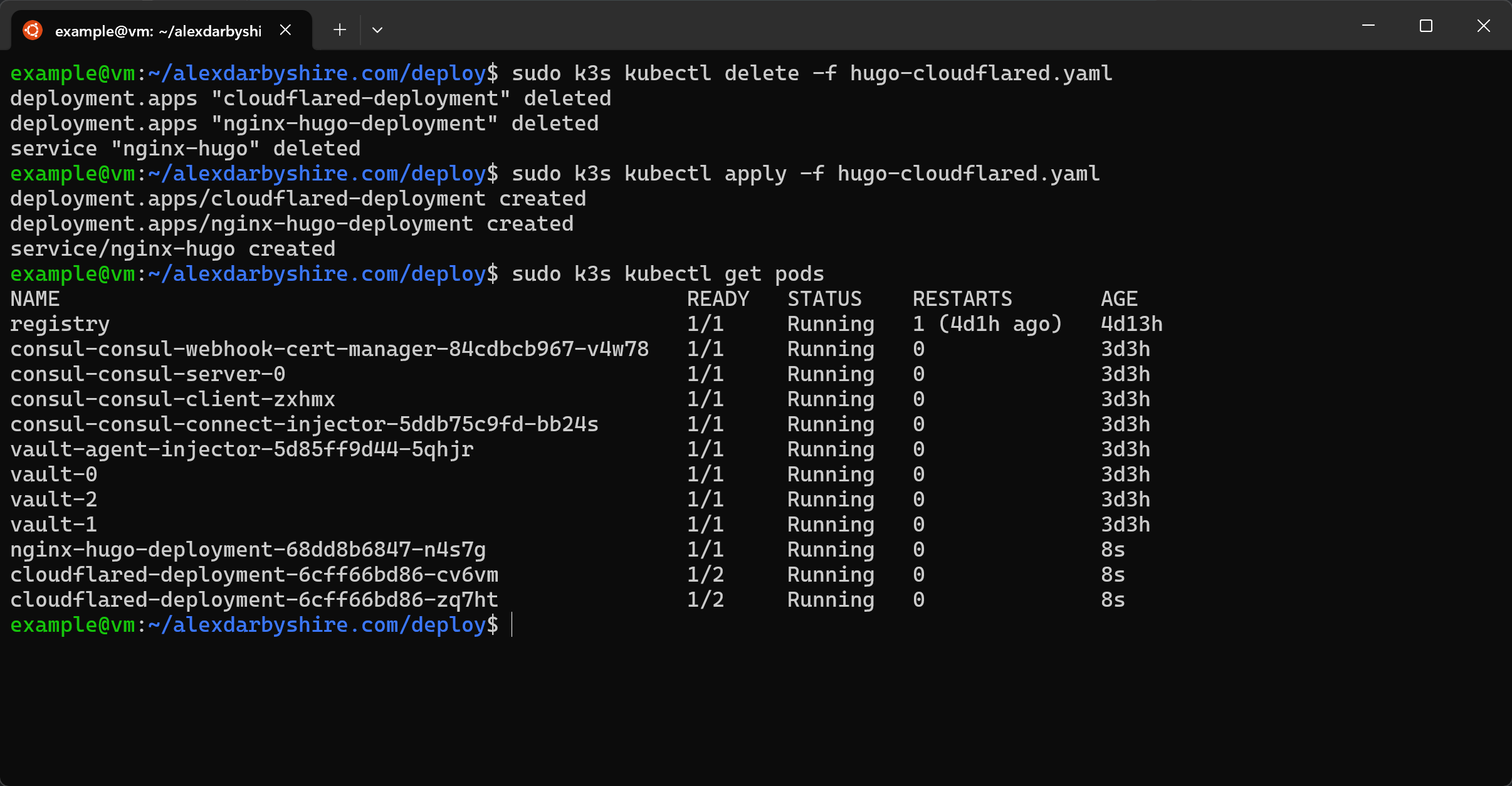
Looks good. We can double-check Nginx is receiving requests by browsing to the site and then checking pod logs.
sudo k3s kubectl logs -f *name_of_pod*
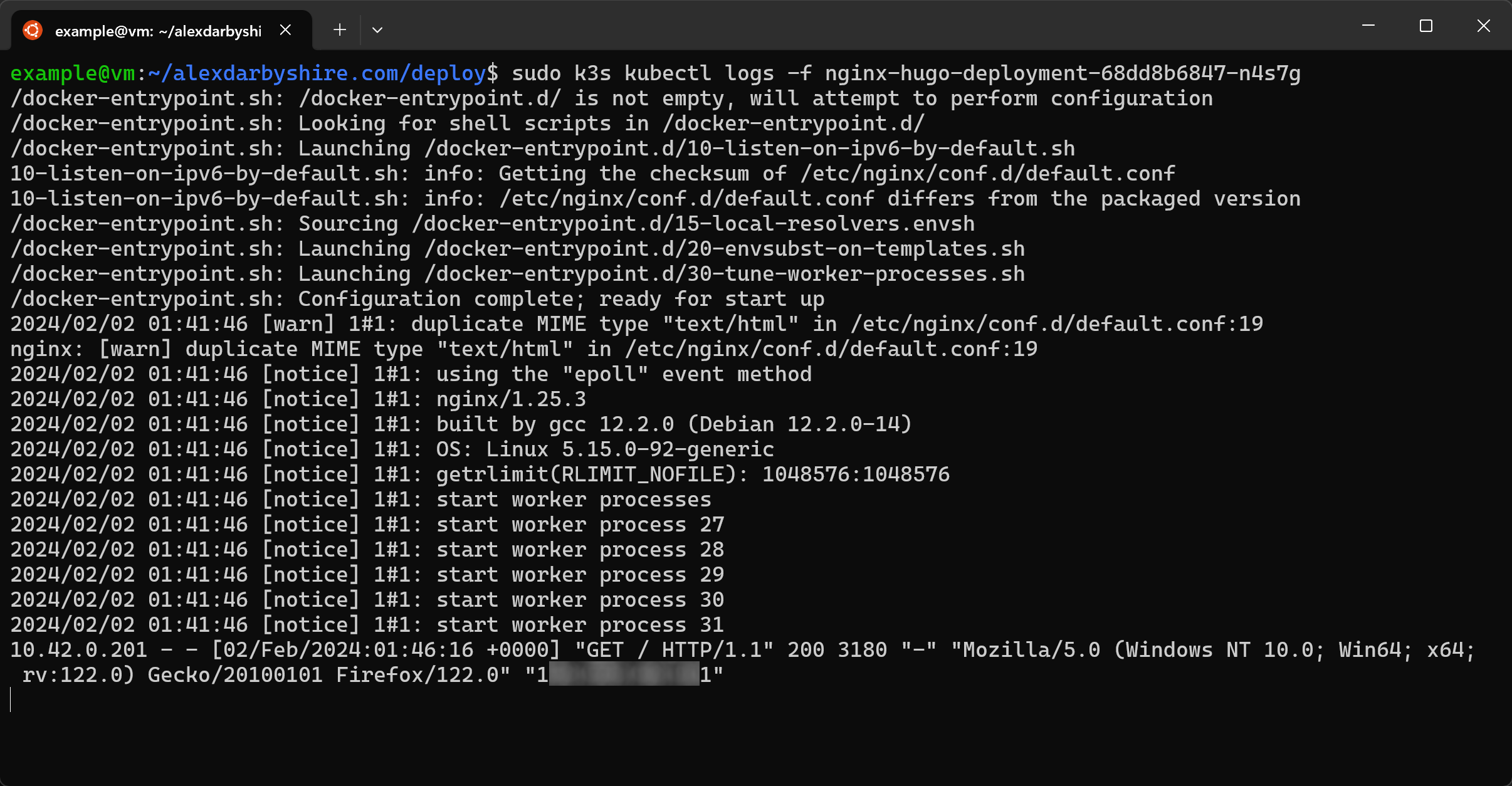
Success!
Cleanup#
rm secrets.yaml
rm secrets.yaml.example
Make a commit#
git add .
git commit -m "Add Vault for secrets management"
Done.#
Time to start thinking about the next project.